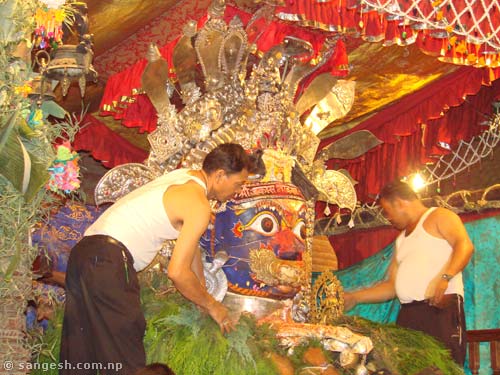 |
| Kathmandu Durbar Sqare |
Prominent Monuments:
Taleju Temple:
 |
| Taleju Temple |
The temple built by King Mahendra Malla in 1562 A.D was dedicated to the royal deity of the Malla Kings. Resting on a 12 stage plinth, the temple is 36.6 meter high. The temple is opened to the public just once in a year during Dashain (sept-Oct).
Krishna Temple:
| Krishna Temple |
This octagonal temple dedicated to Lord Krishna was built in 1649 AD by Pratap Malla in memory of his two dead queens. There is a mention in the epigraph that the temple contains the statue of the king and his queens representing as Lord Krishna and his consorts.
Jagannath Temple:
| Jagannath Temple |
The image of Jagannath was installed in 1563 AD during the resign of Mahendra Malla and the temple is famous for erotic carvings.
Stone column:
The stone column represents the statue of King Pratap Malla in praying gesture to goddess Taleju - The Royal Family Deity.
Degutalle Temple:
| Degutalle Temple |
A tantric goddess representing the family deity of the Malla kings is enshrined in the temple and access is restricted to visitors. The temple lies opposite the stone column and was built in 1671 AD by king Shiva Singh and later renovated by King Pratap Malla.
Hanuman Statue:
| Hanuman Statue |
Kneeling Hanuman, the monkey god, seated on a stone pedestal adn flanked by a pair of lions symbolizes strength and protection against all possible threats. The Hanuman pedestral was erected by King Pratap Malla in 1672 AD.
Shiva-Parvati Temple:
| Shiva-Parvati Temple |
The devine couple Shiva and his consort Parvati look out from the central window of the first floor as the temple was built during the rein of King Rana Bahadur Shah.
Big Bell:
| Big Bell at Kathmandu Durbar Square |
The bell erected in 1797 AD by King Rana Bahadur Shah is rung only when worship is being offered in Degutalle temple situated nearby.
Kal Bhairav:
| Kal Bhairav |
Shiva in his ferocious from is known as Bhairav. This is one of the largest image of Bhairav and was erected by King Pratap Malla.
Maju Dewal:
This temple dedicated to Shiva was built in the late 17th century by Queen Mother Riddhi Laxmi and rests on a nine plinth base dominating the square and commanding a good view of the area.
Trilokya Mohan Narayan:
| Trilokya Mohan Narayan |
This Vishnu temple of late 17th century near the Kumari Ghar, was built on a five stage plint by King Parthibendra in memory of his deceased brother. There is a kneeling image of Garuda-the vehicle of Vishnu, near the temple. During Indrajatra (chariot festival) large crowd gather here to see the ten incarnations of Vishnu enacted on the pedestal.
Kumari Ghar:
| Kumari Ghar |
Kumari Ghar built in 1757 AD by King Jaya Prakash Malla is the house of the living goddess 'Kumari' who is believed to the incarnation of goddess Taleju the protective deity. Kumari often provide her blessing from the window to the visitors.
Basantapur Durbar:
| Basantapur Durbar |
The Basantapur Durbar also known as Nau-talle durbar was built by King Prithvi Narayan Shah in 1770 AD. Alongside there are other high standing pagodas known as Kirtipur Tower, Bhaktapur Tower and Lalitpur Tower.
Gaddi Baithak:
| Gaddi Baithak |
This neoclassical building was built by Chandra Shumsher in 1908 AD during the reign of King Prithvi Bir Bikram Shah. Such kind of buildings was constructed because of Nepal's contact with the west in the second half of the 18th century.
Kasthamandap:
| Kasthamandap |
This 12th century wodden building is said to be constructed from the wood of a single tree hence Kathmandu obtains its name from this historic building, Kasthamandap. The building was used for public gathering during those days. The central image in the building consists of Gorakhnath and there are miniature temples of four Ganeshas.
Ashok Vinayak:
This temple dedicated to the elephant god Ganesha is revered both by the Hindus and Buddhists alike and is one of the most important shrine in the valley.
Dhansa:
| Dhansa |
This temple was built in 1673 AD by Pratap Malla to start a new masked dance of Narasimha, an incarnation of Vishnu.
No comments:
Post a Comment